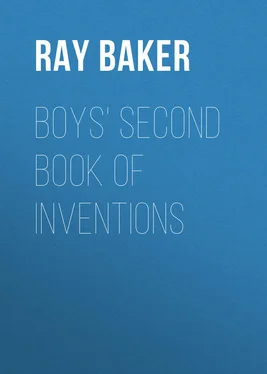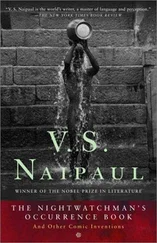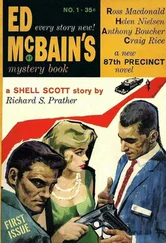Ray Baker - Boys' Second Book of Inventions
Здесь есть возможность читать онлайн «Ray Baker - Boys' Second Book of Inventions» — ознакомительный отрывок электронной книги совершенно бесплатно, а после прочтения отрывка купить полную версию. В некоторых случаях можно слушать аудио, скачать через торрент в формате fb2 и присутствует краткое содержание. Издательство: Иностранный паблик, Жанр: foreign_antique, foreign_prose, foreign_children, на английском языке. Описание произведения, (предисловие) а так же отзывы посетителей доступны на портале библиотеки ЛибКат.
- Название:Boys' Second Book of Inventions
- Автор:
- Издательство:Иностранный паблик
- Жанр:
- Год:неизвестен
- ISBN:нет данных
- Рейтинг книги:4 / 5. Голосов: 1
-
Избранное:Добавить в избранное
- Отзывы:
-
Ваша оценка:
- 80
- 1
- 2
- 3
- 4
- 5
Boys' Second Book of Inventions: краткое содержание, описание и аннотация
Предлагаем к чтению аннотацию, описание, краткое содержание или предисловие (зависит от того, что написал сам автор книги «Boys' Second Book of Inventions»). Если вы не нашли необходимую информацию о книге — напишите в комментариях, мы постараемся отыскать её.
Boys' Second Book of Inventions — читать онлайн ознакомительный отрывок
Ниже представлен текст книги, разбитый по страницам. Система сохранения места последней прочитанной страницы, позволяет с удобством читать онлайн бесплатно книгу «Boys' Second Book of Inventions», без необходимости каждый раз заново искать на чём Вы остановились. Поставьте закладку, и сможете в любой момент перейти на страницу, на которой закончили чтение.
Интервал:
Закладка:
His life was thus saved almost miraculously; but the accident did not deter him from going forward immediately with other experiments. The next year, 1899, he built a new air-ship called Santos-Dumont II., and made an ascension with it, but it dissatisfied him and he at once began with Santos-Dumont III., with which he made the first trip around the Eiffel Tower.
He now made ready to compete for the Deutsch prize of $20,000. The winning of this prize demanded that the trip from Saint-Cloud to the Eiffel Tower, around it and back to the starting place, a distance of some eight miles, should be made in half an hour. For this purpose he finished a much larger air-ship, Santos-Dumont V., in 1901. After a trial, made on July 12, which was attended by several accidents, the inventor decided to make a start early on the following morning, July 13. As early as four o'clock he was ready, and a crowd had begun to gather in the park.
At 6.20 the great sliding doors of the balloon-house were pushed open, and the massive inflated occupant was towed out into the open space of the park. The big pointed nose of the balloon and its fish-like belly resembled a shark gliding with lazy craft from a shadow into light waters. In the basket of the car stood the coatless aëronaut, who laughed and chatted like a boy with the crowd around him.
From the very first the conditions did not show themselves favourable for the attempt. The wind was blowing at the rate of six or seven yards a second. The change of temperature from the balloon-house to the cool morning air had somewhat condensed the hydrogen gas of the balloon, so that one end flapped about in a flabby manner. Air was pumped into the air reservoir, inside the balloon, but still the desired rigidity was not attained. But, more discouraging yet, when the motor was started, its continuous explosions gave to the practised ear signs of mechanical discord.
Nevertheless, Santos-Dumont, with his sleeves rolled up, fixed himself in his basket. His eye took a careful survey of the entire air-ship lest some preliminary had been overlooked. He counted the ballast bags under his feet in the basket, he looked to the canvas pocket of loose sand at either hand, then saw to his guide-rope.
There is a very great deal to look after in managing such a ship, and it requires a calm head and a steady hand to do it.
"Near the saddle on which I sat," he writes, "were the ends of the cords and other means for controlling the different parts of the mechanism – the electric sparking of the motor, the regulation of the carburetter, the handling of the rudder, ballast, and the shifting weights (consisting of the guide-rope and bags of sand), the managing of the balloon's valves, and the emergency rope for tearing open the balloon. It may easily be gathered from this enumeration that an air-ship, even as simple as my own, is a very complex organism; and the work incumbent on the aëronaut is no sinecure."
Several friends shook his hand, among them Mr. Deutsch. The place was very still as the man holding the guide-rope awaited the signal to let go. Then the little man in the basket above them raised his hands and shouted.
At first it did not look like a race against time. The balloon rose sluggishly, and Santos-Dumont had to dump out bag after bag of sand, till finally the guide-rope was clear of the trees. All this gave him no opportunity to think of his direction, and he was drifting toward Versailles; but while yet over the Seine he pulled his rudder ropes taut. Then slowly, gracefully, the enormous spindle veered round and pointed its nose toward the Eiffel Tower. The fans spun energetically, and the air-ship settled down to business-like travelling. It marked a straight, decided line for its goal, then followed the chosen route with a considerable speed. Soon the chug-chugging of the motor could be heard no longer by the spectators, and the balloon and car grew smaller and smaller in its halo of light smoke. Those in the park saw only the screw and the rear of the balloon, like the stern of a steamer in dry dock. Before long only a dot remained against the sky. Gradually he came nearer again, almost returning to the park, but the wind drove him back across the river Seine. Suddenly the motor stopped, and the whole air-ship was seen to fall heavily toward the earth. The crowd raced away expecting to find Santos-Dumont dead and his air-ship a wreck. But they found him on his feet, with his hands in his pockets, reflectively looking up at his air-ship among the top branches of some chestnut trees in the grounds of Baron Edmund de Rothschild, Boulevard de Boulogne.
"This," he says, "was near the hôtel of Princesse Ysabel, Comtesse d'Eu, who sent up to me in my tree a champagne lunch, with an invitation to come and tell her the story of my trip.
"When my story was over, she said to me:
"'Your evolutions in the air made me think of the flight of our great birds of Brazil. I hope that you will succeed for the glory of our common country.'"
And an examination showed that the air-ship was practically uninjured.
So he escaped death a second time. Less than a month later he had a still more terrible mishap, best related in his own words. He says:
"And now I come to a terrible day – August 8, 1901. At 6.30 A.M., I started for the Eiffel Tower again, in the presence of the committee, duly convoked. I turned the goal at the end of nine minutes, and took my way back to Saint-Cloud; but my balloon was losing hydrogen through the automatic valves, the spring of which had been accidentally weakened; and it shrank visibly. All at once, while over the fortifications of Paris, near La Muette, the screw-propeller touched and cut the suspension-cords, which were sagging behind. I was obliged to stop the motor instantly; and at once I saw my air-ship drift straight back to the Eiffel Tower. I had no means of avoiding the terrible danger, except to wreck myself on the roofs of the Trocadero quarter. Without hesitation I opened the manœuvre-valve, and sent my balloon downward.
"At 32 metres (106 feet) above the ground, and with the noise of an explosion, it struck the roof of the Trocadero Hotels. The balloon-envelope was torn to rags, and fell into the courtyard of the hotels, while I remained hanging 15 metres (50 feet) above the ground in my wicker basket, which had been turned almost over, but was supported by the keel. The keel of the Santos-Dumont V. saved my life that day.
"After some minutes a rope was thrown down to me; and, helping myself with feet and hands up the wall (the few narrow windows of which were grated like those of a prison), I was hauled up to the roof. The firemen from Passy had watched the fall of the air-ship from their observatory. They, too, hastened to the rescue. It was impossible to disengage the remains of the balloon-envelope and suspension apparatus except in strips and pieces.
"My escape was narrow; but it was not from the particular danger always present to my mind during this period of my experiments. The position of the Eiffel Tower as a central landmark, visible to everybody from considerable distances, makes it a unique winning-post for an aërial race. Yet this does not alter the other fact that the feat of rounding the Eiffel Tower possesses a unique element of danger. What I feared when on the ground – I had no time to fear while in the air – was that, by some mistake of steering, or by the influence of some side-wind, I might be dashed against the Tower. The impact would burst my balloon, and I should fall to the ground like a stone. Though I never seek to fly at a great height – on the contrary, I hold the record for low altitude in a free balloon – in passing over Paris I must necessarily move above all its chimney-pots and steeples. The Eiffel Tower was my one danger – yet it was my winning-post!
Читать дальшеИнтервал:
Закладка:
Похожие книги на «Boys' Second Book of Inventions»
Представляем Вашему вниманию похожие книги на «Boys' Second Book of Inventions» списком для выбора. Мы отобрали схожую по названию и смыслу литературу в надежде предоставить читателям больше вариантов отыскать новые, интересные, ещё непрочитанные произведения.
Обсуждение, отзывы о книге «Boys' Second Book of Inventions» и просто собственные мнения читателей. Оставьте ваши комментарии, напишите, что Вы думаете о произведении, его смысле или главных героях. Укажите что конкретно понравилось, а что нет, и почему Вы так считаете.












